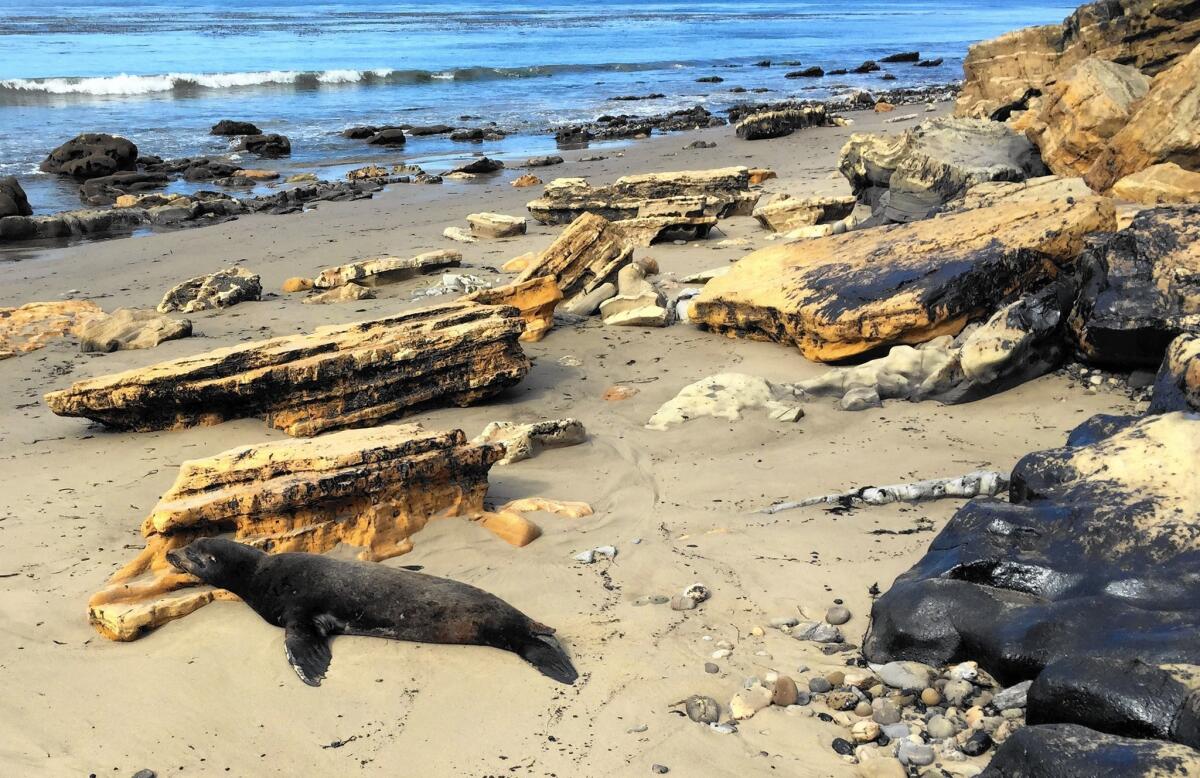More than 700 workers to help with California oil spill cleanup

A sea lion covered in oil struggles on the sand just west of El Refugio State Beach, about 100 feet from where the oil spill flowed into the ocean.
- Share via
Refugio State Beach, Calif. — The number of workers cleaning the coastline after the Santa Barbara County oil spill is expected to swell to more than 700 Friday as the response continues to ramp up, officials said.
Workers have rescued five brown pelicans, as well as a juvenile sea lion partially covered in oil, officials said. The birds have been taken to a facility in San Pedro and the sea lion was taken to SeaWorld for rehabilitation, said California Department of Fish and Wildlife Capt. Mark Crossland.
The female sea lion, estimated to be 1 to 4 years old, was taken to SeaWorld San Diego late Thursday emaciated and with a large amount of oil on its body, face and flippers.
Members of SeaWorld’s rescue team immediately began washing the oil off the animal. A blood sample was taken for examination, and SeaWorld veterinarians and animal care specialists are “cautiously optimistic about her chances for survival and recovery.”
So far, the unified command in charge of the Refugio State Beach recovery effort has not asked SeaWorld to deploy its team to the site, but SeaWorld remains ready, park officials said.
U.S. Coast Guard Jennifer Williams said there has been an “overwhelming” response from the public to volunteer but for now only trained responders and scientists will be working to clean up the crude.
The oil spill occurred Tuesday when a 24-inch-wide pipe installed in 1987 ruptured and poured up to 105,000 gallons of crude into a culvert, with an estimated 21,000 gallons making its way into the Pacific Ocean.
About 9,500 gallons of an oily water mix have been recovered from the ocean, and more than 4,500 feet of boom has been deployed to contain the oil, officials said.
“This week’s spill was unfortunate. Hopefully the environment will prove to be as resilient as Californians have proven to be in the past,” said Mona Bontty with the California Governor’s Office of Emergency Services.
Investigators were working late into the night Thursday to dig up oil-saturated soil around the ruptured Plains All American Pipeline. Company officials said it may take weeks or months to remove the broken stretch of pipe and and determine the cause of the spill.
Federal authorities must first sign off on a plan to examine the pipe before the ruptured portion can be removed, said Rick McMichael, director of pipeline operations for Plains All American Pipeline.
Pumps on both sides of the pipeline had mechanical problems Tuesday morning before a controller saw a drop in pressure on the pipeline and shut it down at 11:30 a.m., he said.
Plains official Patrick Hodgins defended the company’s safety record after a Times analysis of data from the Pipeline and Hazardous Materials Safety Administration showed Plains’ rate of incidents per mile of pipe is more than three times the national average.
He said Plains has more than doubled its safety staff since 2008 and increased spending on maintenance from $50 million in 2008 to more than $300 million last year.
“We know that for some time in the community, we have to earn your trust and we will work 24/7 to do just that,” Hodgins said.
A slick generated by the spill has spread across more than nine square miles of water near the shore, scientists said, with the oil stretching roughly from Arroyo Hondo Creek down to El Capitan State Beach.
Panzar reported from Refugio State Beach and Perry from San Diego.
For breaking California news, follow @jpanzar.
More to Read
Sign up for Essential California
The most important California stories and recommendations in your inbox every morning.
You may occasionally receive promotional content from the Los Angeles Times.













